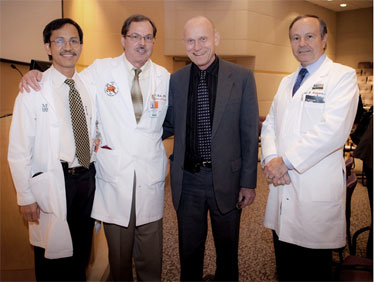
Third from left, David E.R. Sutherland, a transplant pioneer from the University of Minnesota, presented Grand Rounds at a celebration of 40 years of transplant history with, from left, the Miller School’s Si M. Pham, George W. Burke III, and Alan Livingstone.
At a symposium marking the 40th anniversary of the University of Miami/Jackson Memorial Hospital transplant program, Miller School Dean Pascal J. Goldschmidt reflected on the enormous contribution the Miami Transplant Institute has made to medicine, on the physicians there who spend hour after hour in complex surgeries, and on the patients who, over those decades, have come to see the transplant program as a place of hope.
“It is quite remarkable that this outstanding transplant program is happening in a public hospital, in a safety-net hospital,” Dean Goldschmidt said. “At a time when hospitals across the country are facing tremendous economic challenges, you are able to deliver with tremendous results.”
Then he asked a question that set off long and thunderous applause: “How many of you in the room are patients?”
A few in the audience stood up, then a few others, then many more grateful patients whose presence and smiles served as extraordinary testimony. Their doctors, nurses, and other health care and administrative workers sat alongside and shared in the joy.
“I want to thank our transplant teams,” Dean Goldschmidt continued. “They constitute a special part of medicine; every time they treat one patient they save a life. It’s amazing work.”
Among those standing was Cassandra Smith, 43, of Hollywood, who gets overwhelmed when she speaks about her transplant surgery and care.
“I can’t help but get emotional, because I was sick all my life before I got the transplant at the age of 40,” Smith said. “Now it’s no more insulin, no more feeling sick. I have a new heart, a new kidney, and new pancreas. I am blessed, and my doctors are so good.”
The October 20 event at the Lois Pope LIFE Center began with a special Grand Rounds presented by transplant pioneer David E. R. Sutherland, professor of surgery at the University of Minnesota and director of the Schulze Diabetes Institute, then moved into the symposium that reflected on the transplant program’s four decades of giving people like Smith renewed life.
The evening’s program also included remarks from Jackson Health System President and CEO Eneida Roldan, and featured Alan S. Livingstone, Lucille and DeWitt Daughtry Professor and Chairman of the Department of Surgery and the UM/Jackson’s world-renowned transplant surgeons: George Burke, III, chief of the Division of Kidney and Pancreas Transplantation; and Si Pham, chief of the Division of Heart and Lung Transplantation.
The third division chief, Andreas Tzakis, chief of the Division of Liver and Gastrointestinal Transplant, was unable to attend because he was in surgery. His colleagues praised his dedication to his patients, no matter where or when they need him.
That level of commitment has been a hallmark of the transplant program, which began in 1970 when the first kidney transplant was done at UM. Under the guidance of Burke, Tzakis, and Pham, the transplant divisions have performed more than 500 transplant procedures each year, placing the institute, which is a Center of Excellence at the Miller School, among the elite, high-volume transplant centers in the nation.
In addition to liver, kidney, pancreas, and heart transplants, the institute’s surgeons perform complex intestinal and multi-visceral transplants, making the center one of just a few in the world that undertake such extraordinary procedures.
The U.S. Department of Health and Human Services recently recognized the institute’s kidney transplant program with a Silver level award, one of only 10 transplant programs in the country to earn that honor, while the liver and pancreas programs received Bronze level recognition. The HHS’s Donation and Transplantation Community of Practice based the awards on graft survival one year after transplant, transplant rate, and mortality rate after being placed on the transplant list.
At the event, speakers such as attorney Andrea Kessler, the first kidney-pancreas transplant patient, expressed their gratitude.
“I thank all the doctors here for the time they put into research, for the time they put into the hospital, and I thank their families — the long hours they spend working, that’s time they’re probably not with their families,” Kessler said. “I can recall Dr. Burke showing up in my hospital room sometimes at midnight or 1 o’clock in the morning, after he had saved another life.”
“When we do a transplant, these patients become a part of our extended family,” Livingstone said. “As this wonderful symposium made evident, when these patients come to us, they stay with us. So, initially we have patients, but they become friends, they become part of our family. We enter into a contract with them that lasts a lifetime.”








